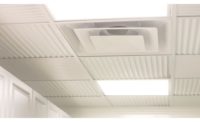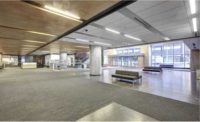ROCKFON acoustic stone wool ceiling panels add a modern look and performance to the historic Minsk National Airport in the Republic of Belarus. The airport connects Western Europe and the Commonwealth of Independent States and underwent significant renovations in 2014. Chief project architect of Minskproyekt Municipal Unitary Engineering Design Enterprise, Oleg V. Sergeyev, selected a combination of Tropic and Artic stone wool panels to meet the modern aesthetic, plus the performance requirements for fire safety and acoustics.
Constructed in the 1980s, the Minsk National Airport was built to serve approximately 5.2 million passengers per year. Initially, upward of 80 percent of airport traffic was carried within the Union of Soviet Socialist Republics (USSR). In the 1990s, the USSR dissolved and the Republic of Belarus formed. With the changing geopolitical situation, the airport became an increasingly important intersection connecting Western Europe and the Commonwealth of Independent States (CIS). However, airport capacity dramatically dropped around the change of the millennium and the existing building ceased to comply with international standards.
The airport’s 2014 renovation and expansion brought the building up to current local standards, increased capacity for international airline traffic by up to 70 percent and improved the travel experience for passengers. ”The objectives of a reconstruction and the construction of a new building differ greatly from each other,” explains Sergeyev. “In this case, we had to work with the existing size and architecture of the building that was built in the former Soviet Union era. The idea of the project was to create an entirely new interior space with a modern, light and airy architecture within the boundaries of the existing building.”
Sergeyev says he found inspiration in the spatial principles introduced by the legendary Swiss-French architect Le Corbusier. ”We have dramatically changed the entire interior, streamlined the terminal area, created entirely new paths of passenger traffic, and re-thought the location of check-in counters and waiting rooms to provide passengers with the necessary level of service.”
He elaborates, ”Working on the airport project we also had to meet the international standards for passenger service and noise while creating a comfortable indoor environment. That is why we paid special attention to the selection of building materials. We chose the ROCKFON ceilings because they fully meet our standards for fire safety and acoustics. ROCKFON products are a contemporary and novel solution in our market that we were able to choose based on their value-to-quality ratio.”
The company’s Kirby Williams agrees, “Both ROCKFON Artic and Tropic offer an attractive appearance at an attractive price point appearance. Extending their value, these panels are easy to install and simple to maintain, while meeting high performance criteria.” Williams serves as product manager for acoustic ceiling tile in North America.
Sound-absorbent Tropic ceiling panels offer Noise Reduction Coefficients (NRC) up to 0.90. Williams says, “With a high NRC, our ceiling panels help reduce the stressful din of noisy travelers and make it easier to hear important announcements in an international airport.”
Non-combustible, stone wool can withstand temperatures up to 2150 °F (1177 °C) and resists melting, burning or creating significant smoke, which improves overall fire safety and limits building damage. The panels are dimensionally stable at up to 100 percent relative humidity and factory painted, providing low maintenance and long-term durability.
Chris Marshall, ROCKFON’s vice president of marketing and business development, observes, “Inspired renovations reveal the true potential and beauty of any space – transporting the building from the past to the future. One of the biggest challenges in renovating existing buildings – rather than tearing them down – is convincing people that the final result will be better than a new build. But opinions are shifting.”
He continues, “People are beginning to realize that, when done right, a renovated building is often a more economical and environmentally responsible way to obtain a high-quality space than starting over with new construction. However, one of the biggest challenges can be creating a modern design that combines the history of the structure with modern technology, comfort and conveniences. This is where the choice of materials really makes a difference.”
Project: Minsk National Airport; Republic of Belarus; http://airport.by/en
Architect: Oleg V. Sergeyev; Minskproyekt Municipal Unitary Engineering Design Enterprise; Minsk, Republic of Belarus
Ceiling manufacturer: ROCKFON; www.rockfon.com
Acoustic Ceiling Systems at Minsk National Airport

Photo courtesy of ROCKFON.

Photo courtesy of ROCKFON.

Photo courtesy of ROCKFON.


